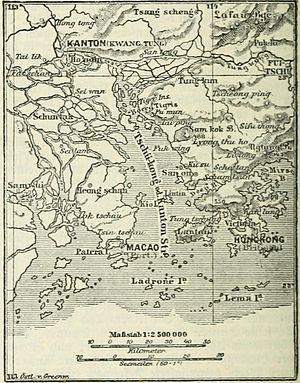Macau Incident (1799)
| Macau Incident | |||||||
|---|---|---|---|---|---|---|---|
| Part of the French Revolutionary Wars | |||||||
 Map of the mouth of the Pearl River. The Wanshan Archipelago labelled "Ladrone In". | |||||||
| |||||||
| Belligerents | |||||||
|
|
| ||||||
| Commanders and leaders | |||||||
| Captain William Hargood |
Rear-Admiral Ignacio Maria de Álava | ||||||
| Strength | |||||||
|
Two ships of the line, one frigate |
Two ships of the line, four frigates | ||||||
| Casualties and losses | |||||||
| None | None | ||||||
The Macau Incident was an inconclusive encounter between a powerful squadron of
The British commander in the East Indies, Rear-Admiral Peter Rainier was concerned about the vulnerability of the China convoy and sent reinforcements to support the lone Royal Navy escort, the ship of the line HMS Intrepid under Captain William Hargood. These reinforcements arrived on 21 January, only six days before the allied squadron arrived off Macau. Despite being outnumbered in ships and guns, Hargood sailed to meet the French and Spanish ships, and a chase ensued through the Wanshan Archipelago before contact was lost. Both sides subsequently claimed that the other had refused battle, although it was the allied squadron which withdrew, Hargood later successfully escorting the China convoy safely westwards.[1]
Background
The
British interests in the East Indies were protected by a large but scattered
Sercey's force had subsequently broken up as it proved too expensive to maintain as a cohesive force. By late 1798, Sercey was at anchor in Batavia with only two vessels, the 20-gun
Incident at Macau
News of the junction of the French and Spanish squadrons reached Rainier soon afterwards. With the assembling merchant ships at Macau were the frigates
The Franco-Spanish squadron, comprising the 74-gun ships of the line
Hargood immediately sailed to confront Alava, both squadrons initially forming
Aftermath
In historian
Hargood sailed from Macau with the China Fleet on 7 February, passing unimpeded into the
Notes
Citations
- ^ Allen, Joseph (1841). Memoir of the Life and Services of Admiral Sir William Hargood. Greenwich, England: H. S. Richardson. pp. 94–95. Archived from the original on 16 November 2022. Retrieved 27 January 2024.
- ^ Woodman 2001, p. 101.
- ^ Clowes 1997, p. 337.
- ^ UK Retail Price Index inflation figures are based on data from Clark, Gregory (2017). "The Annual RPI and Average Earnings for Britain, 1209 to Present (New Series)". MeasuringWorth. Retrieved 11 June 2022.
- ^ Woodman 2001, p. 32.
- ^ a b Woodman 2001b, p. 160.
- ^ a b James 2002, p. 79.
- ^ Parkinson 1954, p. 123.
- ^ Parkinson 1954, p. =123.
- ^ a b Woodman 2001a, p. 115.
- ^ a b Parkinson 1954, p. 124.
- ^ Henderson 1994, p. 49.
- ^ Parkinson 1954, p. 156.
- ^ a b Woodman 2001, p. 115.
- ^ a b c Parkinson 1954, p. 157.
- ^ a b c d Parkinson 1954, p. 158.
- ^ Parkinson 1954, p. 131.
References
- ISBN 1-86176-014-0.
- Henderson, James (1994) [1970]. The Frigates. London: Leo Cooper. ISBN 0-85052-432-6.
- ISBN 0-85177-906-9.
- McGrigor, Mary (2004). Defiant and Dismasted at Trafalgar: The Life and Times of Admiral Sir William Hargood. Pen and Sword. ISBN 9781844150342.
- OCLC 460032956.
- Woodman, Richard (2001b) [1996]. Gardiner, Robert (ed.). Nelson Against Napoleon: from the Nile to Copenhagen, 1798–1801. London: Chatham and the ISBN 1-86176-026-4.
- Woodman, Richard (2001) [1998]. Gardiner, Robert (ed.). The Victory of Seapower. London, England: Caxton Editions. ISBN 1-84067-359-1.
- ISBN 1-84119-183-3.
